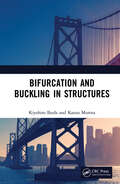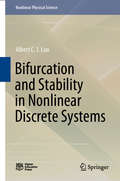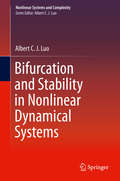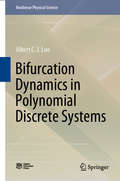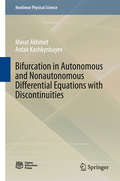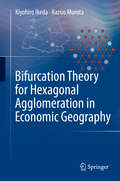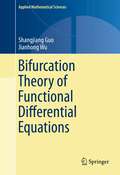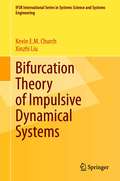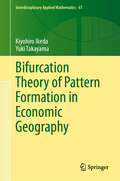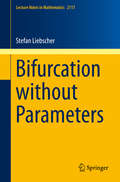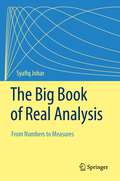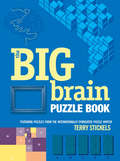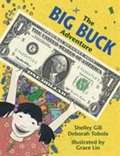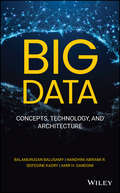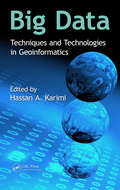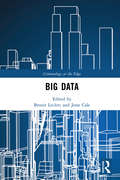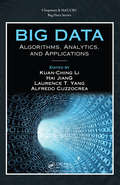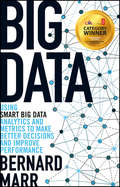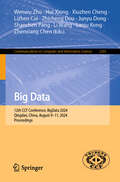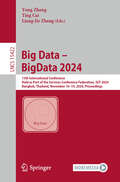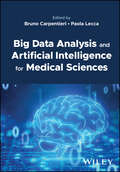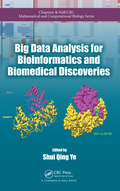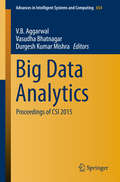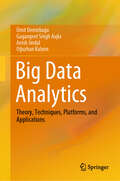- Table View
- List View
Bifurcation and Buckling in Structures
by Kiyohiro Ikeda Kazuo MurotaBifurcation and Buckling in Structures describes the theory and analysis of bifurcation and buckling in structures. Emphasis is placed on a general procedure for solving nonlinear governing equations and an analysis procedure related to the finite-element method. Simple structural examples using trusses, columns, and frames illustrate the principles. Part I presents fundamental issues such as the general mathematical framework for bifurcation and buckling, procedures for the buckling load/mode analyses, and numerical analysis procedures to trace the solution curves and switch to bifurcation solutions. Advanced topics include asymptotic theory of bifurcation and bifurcation theory of symmetric systems. Part II deals with buckling of perfect and imperfect structures. An overview of the member buckling of columns and beams is provided, followed by the buckling analysis of truss and frame structures. The worst and random imperfections are studied as advanced topics. An extensive review of the history of buckling is presented. This text is ideal for advanced undergraduate and graduate students in engineering and applied mathematics. To assist readers, problems are listed at the end of each chapter, and their answers are given at the end of the book. Kiyohiro Ikeda is Professor Emeritus at Tohoku University, Japan. Kazuo Murota is a Project Professor at the Institute of Statistical Mathematics, Japan, as well as Professor Emeritus at the University of Tokyo, Kyoto University, and Tokyo Metropolitan University, Japan.
Bifurcation and Stability in Nonlinear Discrete Systems (Nonlinear Physical Science)
by Albert C. LuoThis book focuses on bifurcation and stability in nonlinear discrete systems, including monotonic and oscillatory stability. It presents the local monotonic and oscillatory stability and bifurcation of period-1 fixed-points on a specific eigenvector direction, and discusses the corresponding higher-order singularity of fixed-points. Further, it explores the global analysis of monotonic and oscillatory stability of fixed-points in 1-dimensional discrete systems through 1-dimensional polynomial discrete systems. Based on the Yin-Yang theory of nonlinear discrete systems, the book also addresses the dynamics of forward and backward nonlinear discrete systems, and the existence conditions of fixed-points in said systems. Lastly, in the context of local analysis, it describes the normal forms of nonlinear discrete systems and infinite-fixed-point discrete systems. Examining nonlinear discrete systems from various perspectives, the book helps readers gain a better understanding of the nonlinear dynamics of such systems.
Bifurcation and Stability in Nonlinear Dynamical Systems (Nonlinear Systems and Complexity #28)
by Albert C. LuoThis book systematically presents a fundamental theory for the local analysis of bifurcation and stability of equilibriums in nonlinear dynamical systems. Until now, one does not have any efficient way to investigate stability and bifurcation of dynamical systems with higher-order singularity equilibriums. For instance, infinite-equilibrium dynamical systems have higher-order singularity, which dramatically changes dynamical behaviors and possesses the similar characteristics of discontinuous dynamical systems. The stability and bifurcation of equilibriums on the specific eigenvector are presented, and the spiral stability and Hopf bifurcation of equilibriums in nonlinear systems are presented through the Fourier series transformation. The bifurcation and stability of higher-order singularity equilibriums are presented through the (2m)th and (2m+1)th -degree polynomial systems. From local analysis, dynamics of infinite-equilibrium systems is discussed. The research on infinite-equilibrium systems will bring us to the new era of dynamical systems and control. Presents an efficient way to investigate stability and bifurcation of dynamical systems with higher-order singularity equilibriums;Discusses dynamics of infinite-equilibrium systems;Demonstrates higher-order singularity.
Bifurcation Dynamics in Polynomial Discrete Systems (Nonlinear Physical Science)
by Albert C. LuoThis is the first book focusing on bifurcation dynamics in 1-dimensional polynomial nonlinear discrete systems. It comprehensively discusses the general mathematical conditions of bifurcations in polynomial nonlinear discrete systems, as well as appearing and switching bifurcations for simple and higher-order singularity period-1 fixed-points in the 1-dimensional polynomial discrete systems. Further, it analyzes the bifurcation trees of period-1 to chaos generated by period-doubling, and monotonic saddle-node bifurcations. Lastly, the book presents methods for period-2 and period-doubling renormalization for polynomial discrete systems, and describes the appearing mechanism and period-doublization of period-n fixed-points on bifurcation trees for the first time, offering readers fascinating insights into recent research results in nonlinear discrete systems.
Bifurcation in Autonomous and Nonautonomous Differential Equations with Discontinuities (Nonlinear Physical Science)
by Marat Akhmet Ardak KashkynbayevThis book is devoted to bifurcation theory for autonomous and nonautonomous differential equations with discontinuities of different types. That is, those with jumps present either in the right-hand-side or in trajectories or in the arguments of solutions of equations. The results obtained in this book can be applied to various fields such as neural networks, brain dynamics, mechanical systems, weather phenomena, population dynamics, etc. Without any doubt, bifurcation theory should be further developed to different types of differential equations. In this sense, the present book will be a leading one in this field. The reader will benefit from the recent results of the theory and will learn in the very concrete way how to apply this theory to differential equations with various types of discontinuity. Moreover, the reader will learn new ways to analyze nonautonomous bifurcation scenarios in these equations. The book will be of a big interest both for beginners and experts in the field. For the former group of specialists, that is, undergraduate and graduate students, the book will be useful since it provides a strong impression that bifurcation theory can be developed not only for discrete and continuous systems, but those which combine these systems in very different ways. The latter group of specialists will find in this book several powerful instruments developed for the theory of discontinuous dynamical systems with variable moments of impacts, differential equations with piecewise constant arguments of generalized type and Filippov systems. A significant benefit of the present book is expected to be for those who consider bifurcations in systems with impulses since they are presumably nonautonomous systems.
Bifurcation Theory for Hexagonal Agglomeration in Economic Geography
by Kiyohiro Ikeda Kazuo MurotaThis book contributes to an understanding of how bifurcation theory adapts to the analysis of economic geography. It is easily accessible not only to mathematicians and economists, but also to upper-level undergraduate and graduate students who are interested in nonlinear mathematics. The self-organization of hexagonal agglomeration patterns of industrial regions was first predicted by the central place theory in economic geography based on investigations of southern Germany. The emergence of hexagonal agglomeration in economic geography models was envisaged by Krugman. In this book, after a brief introduction of central place theory and new economic geography, the missing link between them is discovered by elucidating the mechanism of the evolution of bifurcating hexagonal patterns. Pattern formation by such bifurcation is a well-studied topic in nonlinear mathematics, and group-theoretic bifurcation analysis is a well-developed theoretical tool. A finite hexagonal lattice is used to express uniformly distributed places, and the symmetry of this lattice is expressed by a finite group. Several mathematical methodologies indispensable for tackling the present problem are gathered in a self-contained manner. The existence of hexagonal distributions is verified by group-theoretic bifurcation analysis, first by applying the so-called equivariant branching lemma and next by solving the bifurcation equation. This book offers a complete guide for the application of group-theoretic bifurcation analysis to economic agglomeration on the hexagonal lattice.
Bifurcation Theory of Functional Differential Equations (Applied Mathematical Sciences #184)
by Jianhong Wu Shangjiang GuoThis book provides a crash course on various methods from the bifurcation theory of Functional Differential Equations (FDEs). FDEs arise very naturally in economics, life sciences and engineering and the study of FDEs has been a major source of inspiration for advancement in nonlinear analysis and infinite dimensional dynamical systems. The book summarizes some practical and general approaches and frameworks for the investigation of bifurcation phenomena of FDEs depending on parameters with chap. This well illustrated book aims to be self contained so the readers will find in this book all relevant materials in bifurcation, dynamical systems with symmetry, functional differential equations, normal forms and center manifold reduction. This material was used in graduate courses on functional differential equations at Hunan University (China) and York University (Canada).
Bifurcation Theory of Impulsive Dynamical Systems (IFSR International Series in Systems Science and Systems Engineering #34)
by Kevin E.M. Church Xinzhi LiuThis monograph presents the most recent progress in bifurcation theory of impulsive dynamical systems with time delays and other functional dependence. It covers not only smooth local bifurcations, but also some non-smooth bifurcation phenomena that are unique to impulsive dynamical systems. The monograph is split into four distinct parts, independently addressing both finite and infinite-dimensional dynamical systems before discussing their applications. The primary contributions are a rigorous nonautonomous dynamical systems framework and analysis of nonlinear systems, stability, and invariant manifold theory. Special attention is paid to the centre manifold and associated reduction principle, as these are essential to the local bifurcation theory. Specifying to periodic systems, the Floquet theory is extended to impulsive functional differential equations, and this permits an exploration of the impulsive analogues of saddle-node, transcritical, pitchfork and Hopf bifurcations.Readers will learn how techniques of classical bifurcation theory extend to impulsive functional differential equations and, as a special case, impulsive differential equations without delays. They will learn about stability for fixed points, periodic orbits and complete bounded trajectories, and how the linearization of the dynamical system allows for a suitable definition of hyperbolicity. They will see how to complete a centre manifold reduction and analyze a bifurcation at a nonhyperbolic steady state.
Bifurcation Theory of Pattern Formation in Economic Geography (Interdisciplinary Applied Mathematics #61)
by Kiyohiro Ikeda Yuki TakayamaDive into the fascinating world of economic agglomerations with this interdisciplinary study, which is perfect for readers in nonlinear mathematics, economic geography, and spatial economics. This book uniquely bridges these fields, employing group-theoretic bifurcation analysis in nonlinear mathematics to establish a robust theoretical foundation for economic geographers and mathematicians alike. Explore innovative models that describe the pattern formation in economic agglomerations through worker migration between regions. Delve into multi-regional formulations of classic economic geography models, applied to various spatial platforms such as line segments, racetracks, squares, and hexagonal lattices. This book, ideal for researchers and practitioners, offers cutting-edge insights and methodologies for understanding the complexities of spatial economic agglomerations.
Bifurcation without Parameters (Lecture Notes in Mathematics #2117)
by Stefan LiebscherTargeted at mathematicians having at least a basic familiarity with classical bifurcation theory, this monograph provides a systematic classification and analysis of bifurcations without parameters in dynamical systems. Although the methods and concepts are briefly introduced, a prior knowledge of center-manifold reductions and normal-form calculations will help the reader to appreciate the presentation. Bifurcations without parameters occur along manifolds of equilibria, at points where normal hyperbolicity of the manifold is violated. The general theory, illustrated by many applications, aims at a geometric understanding of the local dynamics near the bifurcation points.
The Big Bang of Numbers: How to Build the Universe Using Only Math
by Manil SuriAn engaging and imaginative tour through the fundamental mathematical concepts—from arithmetic to infinity—that form the building blocks of our universe. Our universe has multiple origin stories, from religious creation myths to the Big Bang of scientists. But if we leave those behind and start from nothing—no matter, no cosmos, not even empty space—could we create a universe using only math? Irreverent, richly illustrated, and boundlessly creative, The Big Bang of Numbers invites us to try. In this new mathematical origin story, mathematician and novelist Manil Suri creates a natural progression of ideas needed to design our world, starting with numbers and continuing through geometry, algebra, and beyond. He reveals the secret lives of real and imaginary numbers, teaches them to play abstract games with real-world applications, discovers unexpected patterns that connect humble lifeforms to enormous galaxies, and explores mathematical underpinnings for randomness and beauty. With evocative examples ranging from multidimensional crochet to the Mona Lisa’s asymmetrical smile, as well as ingenious storytelling that helps illuminate complex concepts like infinity and relativity, The Big Bang of Numbers charts a playful, inventive course to existence. Mathematics, Suri shows, might best be understood not as something we invent to explain Nature, but as the source of all creation, whose directives Nature tries to obey as best she can. Offering both striking new perspectives for math aficionados and an accessible introduction for anyone daunted by calculation, The Big Bang of Numbers proves that we can all fall in love with math.
The Big Book of Real Analysis: From Numbers to Measures
by Syafiq JoharThis book provides an introduction to real analysis, a fundamental topic that is an essential requirement in the study of mathematics. It deals with the concepts of infinity and limits, which are the cornerstones in the development of calculus. Beginning with some basic proof techniques and the notions of sets and functions, the book rigorously constructs the real numbers and their related structures from the natural numbers. During this construction, the readers will encounter the notions of infinity, limits, real sequences, and real series. These concepts are then formalised and focused on as stand-alone objects. Finally, they are expanded to limits, sequences, and series of more general objects such as real-valued functions. Once the fundamental tools of the trade have been established, the readers are led into the classical study of calculus (continuity, differentiation, and Riemann integration) from first principles. The book concludes with an introduction to the study of measures and how one can construct the Lebesgue integral as an extension of the Riemann integral. This textbook is aimed at undergraduate students in mathematics. As its title suggests, it covers a large amount of material, which can be taught in around three semesters. Many remarks and examples help to motivate and provide intuition for the abstract theoretical concepts discussed. In addition, more than 600 exercises are included in the book, some of which will lead the readers to more advanced topics and could be suitable for independent study projects. Since the book is fully self-contained, it is also ideal for self-study.
The Big Brain Puzzle Book: Entertaining Sudoku, Kakuro, And Brainteasers For Every Day (Little Bathroom Book Ser.)
by Terry StickelsGive your brain a series of workouts that'll make it bigger and better! This colossal collection of more than 200 puzzles simultaneously provides a relaxing atmosphere for mental play and stimulates brain activity. Created by an internationally renowned puzzle-maker, the challenges involve creative thinking, mathematics, logic, language and wordplay, visuals, and general knowledge.Kick start your neurons at Level 1 with puzzles involving hidden words, math calculations, and logical conundrums. At Level 2, fire up your synapses with cryptograms, scrambled sentences, and visual challenges. And activate your brain at Level 3 with fill-in-the-blanks, search-a-words, magic squares, and much more. If you get stumped, an answer key with complete solutions appears at the end.
The Big Buck Adventure
by Shelley Gill Deborah Tobola Grace LinOne little girl and one very big dollar set out on a great adventure at the store. <P><P> However, what seems like a pleasant afternoon of shopping soon turns perplexing as the challenge of her buying options becomes overwhelming. She doesn't know what to do. There are so many choices, but she only has one buck. A fun and perfect example of how we use math in our daily lives.
Big Data: Concepts, Technology, and Architecture
by Balamurugan Balusamy Nandhini Abirami R Seifedine Kadry Amir H. GandomiLearn Big Data from the ground up with this complete and up-to-date resource from leaders in the field Big Data: Concepts, Technology, and Architecture delivers a comprehensive treatment of Big Data tools, terminology, and technology perfectly suited to a wide range of business professionals, academic researchers, and students. Beginning with a fulsome overview of what we mean when we say, “Big Data,” the book moves on to discuss every stage of the lifecycle of Big Data. You’ll learn about the creation of structured, unstructured, and semi-structured data, data storage solutions, traditional database solutions like SQL, data processing, data analytics, machine learning, and data mining. You’ll also discover how specific technologies like Apache Hadoop, SQOOP, and Flume work. Big Data also covers the central topic of big data visualization with Tableau, and you’ll learn how to create scatter plots, histograms, bar, line, and pie charts with that software. Accessibly organized, Big Data includes illuminating case studies throughout the material, showing you how the included concepts have been applied in real-world settings. Some of those concepts include: The common challenges facing big data technology and technologists, like data heterogeneity and incompleteness, data volume and velocity, storage limitations, and privacy concerns Relational and non-relational databases, like RDBMS, NoSQL, and NewSQL databases Virtualizing Big Data through encapsulation, partitioning, and isolating, as well as big data server virtualization Apache software, including Hadoop, Cassandra, Avro, Pig, Mahout, Oozie, and Hive The Big Data analytics lifecycle, including business case evaluation, data preparation, extraction, transformation, analysis, and visualization Perfect for data scientists, data engineers, and database managers, Big Data also belongs on the bookshelves of business intelligence analysts who are required to make decisions based on large volumes of information. Executives and managers who lead teams responsible for keeping or understanding large datasets will also benefit from this book.
Big Data: Techniques and Technologies in Geoinformatics
by Hassan A. KarimiBig data has always been a major challenge in geoinformatics as geospatial data come in various types and formats, new geospatial data are acquired very fast, and geospatial databases are inherently very large. And while there have been advances in hardware and software for handling big data, they often fall short of handling geospatial big data ef
Big Data (Criminology at the Edge)
by Benoit Leclerc Jesse CaleThe internet has launched the world into an era into which enormous amounts of data are generated every day through technologies with both positive and negative consequences. This often refers to big data . This book explores big data in organisations operating in the criminology and criminal justice fields. Big data entails a major disruption in the ways we think about and do things, which certainly applies to most organisations including those operating in the criminology and criminal justice fields. Big data is currently disrupting processes in most organisations – how different organisations collaborate with one another, how organisations develop products or services, how organisations can identify, recruit, and evaluate talent, how organisations can make better decisions based on empirical evidence rather than intuition, and how organisations can quickly implement any transformation plan, to name a few. All these processes are important to tap into, but two underlying processes are critical to establish a foundation that will permit organisations to flourish and thrive in the era of big data – creating a culture more receptive to big data and implementing a systematic data analytics-driven process within the organisation. Written in a clear and direct style, this book will appeal to students and scholars in criminology, criminal justice, sociology, and cultural studies but also to government agencies, corporate and non-corporate organisations, or virtually any other institution impacted by big data.
Big Data: Algorithms, Analytics, and Applications (Chapman And Hall/crc Big Data Ser.)
by Kuan-Ching Li Hai Jiang Laurence T. Yang Alfredo CuzzocreaAs today's organizations are capturing exponentially larger amounts of data than ever, now is the time for organizations to rethink how they digest that data. Through advanced algorithms and analytics techniques, organizations can harness this data, discover hidden patterns, and use the newly acquired knowledge to achieve competitive advantages.Pre
Big Data
by Bernard MarrConvert the promise of big data into real world resultsThere is so much buzz around big data. We all need to know what it is and how it works - that much is obvious. But is a basic understanding of the theory enough to hold your own in strategy meetings? Probably. But what will set you apart from the rest is actually knowing how to USE big data to get solid, real-world business results - and putting that in place to improve performance. Big Data will give you a clear understanding, blueprint, and step-by-step approach to building your own big data strategy. This is a well-needed practical introduction to actually putting the topic into practice. Illustrated with numerous real-world examples from a cross section of companies and organisations, Big Data will take you through the five steps of the SMART model: Start with Strategy, Measure Metrics and Data, Apply Analytics, Report Results, Transform.Discusses how companies need to clearly define what it is they need to knowOutlines how companies can collect relevant data and measure the metrics that will help them answer their most important business questionsAddresses how the results of big data analytics can be visualised and communicated to ensure key decisions-makers understand themIncludes many high-profile case studies from the author's work with some of the world's best known brands
Big Data: 12th CCF Conference, BigData 2024, Qingdao, China, August 9–11, 2024, Proceedings (Communications in Computer and Information Science #2301)
by Wenwu Zhu Hui Xiong Xiuzhen Cheng Lizhen Cui Zhicheng Dou Junyu Dong Shanchen Pang Li Wang Lanju Kong Zhenxiang Chen“This book constitutes the refereed proceedings of the 12th CCF Conference on BigData 2024, which took place in Qingdao, China, in August 2024” to “This book constitutes the refereed proceedings of the 12th CCF Conference on BigData 2024, which took place in Qingdao, China, during 9-11 August, 2024. The 26 full papers presented in this volume were carefully reviewed and selected from 219 submissions. The topics of accepted papers include Big data, Data Science, System Architecture and Infrastructure, Storage Management, Parallel Computing, Analysis Mining and Intelligent Computing, Collection and Preprocessing, Governance.
Big Data – BigData 2024: 13th International Conference, Held as Part of the Services Conference Federation, SCF 2024, Bangkok, Thailand, November 16-19, 2024, Proceedings (Lecture Notes in Computer Science #15422)
by Yong Zhang Ting Cai Liang-Jie ZhangThis book constitutes the refereed proceedings of the 13th International Conference on Big Data, BigData 2024, held as part of the Services Conference Federation, SCF 2024, in Bangkok, Thailand, during November 16-19, 2024. The 8 full papers and 1 short paper included in this book were carefully reviewed and selected from 21 submissions. They focus on various topics within the field of Data-based services such as Big Data Architecture, Big Data Modeling, Big Data As A Service, Big Data for Vertical Industries (Government, Healthcare, etc.), Big Data Analytics, Big Data Toolkits, Big Data Open Platforms, Economic Analysis, Big Data for Enterprise Transformation, Big Data in Business Performance Management, Big Data for Business Model Innovations and Analytics, Big Data in Enterprise Management Models and Practices, Big Data in Government Management Models and Practices, and Big Data in Smart Planet Solutions. The papers have been organized under the following topical sections: Research track; Application track; and Short paper track.
Big Data Analysis and Artificial Intelligence for Medical Sciences
by Paola Lecca Bruno CarpentieriBig Data Analysis and Artificial Intelligence for Medical Sciences Overview of the current state of the art on the use of artificial intelligence in medicine and biology Big Data Analysis and Artificial Intelligence for Medical Sciences demonstrates the efforts made in the fields of Computational Biology and medical sciences to design and implement robust, accurate, and efficient computer algorithms for modeling the behavior of complex biological systems much faster than using traditional modeling approaches based solely on theory. With chapters written by international experts in the field of medical and biological research, Big Data Analysis and Artificial Intelligence for Medical Sciences includes information on: Studies conducted by the authors which are the result of years of interdisciplinary collaborations with clinicians, computer scientists, mathematicians, and engineers Differences between traditional computational approaches to data processing (those of mathematical biology) versus the experiment-data-theory-model-validation cycle Existing approaches to the use of big data in the healthcare industry, such as through IBM’s Watson Oncology, Microsoft’s Hanover, and Google’s DeepMind Difficulties in the field that have arisen as a result of technological changes, and potential future directions these changes may take A timely and up-to-date resource on the integration of artificial intelligence in medicine and biology, Big Data Analysis and Artificial Intelligence for Medical Sciences is of great benefit not only to professional scholars, but also MSc or PhD program students eager to explore advancement in the field.
Big Data Analysis for Bioinformatics and Biomedical Discoveries (Chapman & Hall/CRC Computational Biology Series)
by Shui Qing YeDemystifies Biomedical and Biological Big Data AnalysesBig Data Analysis for Bioinformatics and Biomedical Discoveries provides a practical guide to the nuts and bolts of Big Data, enabling you to quickly and effectively harness the power of Big Data to make groundbreaking biological discoveries, carry out translational medical research, and implem
Big Data Analytics: Proceedings of CSI 2015 (Advances in Intelligent Systems and Computing #654)
by Vasudha Bhatnagar Durgesh Kumar Mishra V. B. AggarwalThis volume comprises the select proceedings of the annual convention of the Computer Society of India. Divided into 10 topical volumes, the proceedings present papers on state-of-the-art research, surveys, and succinct reviews. The volumes cover diverse topics ranging from communications networks to big data analytics, and from system architecture to cyber security. This volume focuses on Big Data Analytics. The contents of this book will be useful to researchers and students alike.
Big Data Analytics: Theory, Techniques, Platforms, and Applications
by Ümit Demirbaga Gagangeet Singh Aujla Anish Jindal Oğuzhan KalyonThis book introduces readers to big data analytics. It covers the background to and the concepts of big data, big data analytics, and cloud computing, along with the process of setting up, configuring, and getting familiar with the big data analytics working environments in the first two chapters. The third chapter provides comprehensive information on big data processing systems - from installing these systems to implementing real-world data applications, along with the necessary codes. The next chapter dives into the details of big data storage technologies, including their types, essentiality, durability, and availability, and reveals their differences in their properties. The fifth and sixth chapters guide the reader through understanding, configuring, and performing the monitoring and debugging of big data systems and present the available commercial and open-source tools for this purpose. Chapter seven gives information about a trending machine learning, Bayesian network: a probabilistic graphical model, by presenting a real-world probabilistic application to understand causal, complex, and hidden relationships for diagnosis and forecasting in a scalable manner for big data. Special sections throughout the eighth chapter present different case studies and applications to help the readers to develop their big data analytics skills using various big data analytics frameworks.The book will be of interest to business executives and IT managers as well as university students and their course leaders, in fact all those who want to get involved in the big data world.
